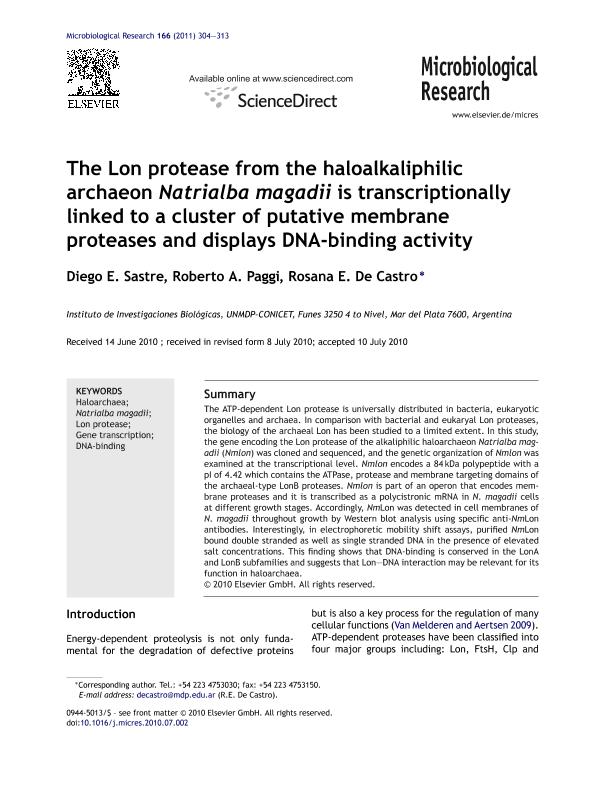Mostrar el registro sencillo del ítem
dc.contributor.author
Sastre, Diego Emiliano

dc.contributor.author
Paggi, Roberto Alejandro
dc.contributor.author
de Castro, Rosana Esther

dc.date.available
2017-02-15T15:40:17Z
dc.date.issued
2011-05
dc.identifier.citation
Sastre, Diego Emiliano; Paggi, Roberto Alejandro; de Castro, Rosana Esther; The Lon protease from the haloalkaliphilic archaeon Natrialba magadii is transcriptionally linked to a cluster of putative membrane proteases and displays DNA-binding activity; Elsevier Gmbh; Microbiological Research; 166; 4; 5-2011; 304-313
dc.identifier.issn
0944-5013
dc.identifier.uri
http://hdl.handle.net/11336/13053
dc.description.abstract
The ATP-dependent Lon protease is universally distributed in bacteria, eukaryotic organelles and archaea. In comparison with bacterial and eukaryal Lon proteases, the biology of the archaeal Lon has been studied to a limited extent. In this study, the gene encoding the Lon protease of the alkaliphilic haloarchaeon Natrialba magadii (Nmlon) was cloned and sequenced, and the genetic organization of Nmlon was examined at the transcriptional level. Nmlon encodes a 84 kDa polypeptide with a pI of 4.42 which contains the ATPase, protease and membrane targeting domains of the archaeal-type LonB proteases. Nmlon is part of an operon that encodes membrane proteases and it is transcribed as a polycistronic mRNA in N. magadii cells at different growth stages. Accordingly, NmLon was detected in cell membranes of N. magadii throughout growth by Western blot analysis using specific anti-NmLon antibodies. Interestingly, in electrophoretic mobility shift assays, purified NmLon bound double stranded as well as single stranded DNA in the presence of elevated salt concentrations. This finding shows that DNA-binding is conserved in the LonA and LonB subfamilies and suggests that Lon–DNA interaction may be relevant for its function in haloarchaea.
dc.format
application/pdf
dc.language.iso
eng
dc.publisher
Elsevier Gmbh

dc.rights
info:eu-repo/semantics/openAccess
dc.rights.uri
https://creativecommons.org/licenses/by-nc-sa/2.5/ar/
dc.subject
Haloarchaea
dc.subject
Natrialba Magadii
dc.subject
Lon Protease
dc.subject
Gene Transcription
dc.subject
Dna-Binding
dc.subject.classification
Biología Celular, Microbiología

dc.subject.classification
Ciencias Biológicas

dc.subject.classification
CIENCIAS NATURALES Y EXACTAS

dc.title
The Lon protease from the haloalkaliphilic archaeon Natrialba magadii is transcriptionally linked to a cluster of putative membrane proteases and displays DNA-binding activity
dc.type
info:eu-repo/semantics/article
dc.type
info:ar-repo/semantics/artículo
dc.type
info:eu-repo/semantics/publishedVersion
dc.date.updated
2017-02-10T18:13:03Z
dc.journal.volume
166
dc.journal.number
4
dc.journal.pagination
304-313
dc.journal.pais
Alemania

dc.journal.ciudad
Munich
dc.description.fil
Fil: Sastre, Diego Emiliano. Consejo Nacional de Investigaciones Científicas y Técnicas. Centro Científico Tecnológico Mar del Plata. Instituto de Investigaciones Biológicas; Argentina. Universidad Nacional de Mar del Plata; Argentina
dc.description.fil
Fil: Paggi, Roberto Alejandro. Consejo Nacional de Investigaciones Científicas y Técnicas. Centro Científico Tecnológico Mar del Plata. Instituto de Investigaciones Biológicas; Argentina. Universidad Nacional de Mar del Plata; Argentina
dc.description.fil
Fil: de Castro, Rosana Esther. Consejo Nacional de Investigaciones Científicas y Técnicas. Centro Científico Tecnológico Mar del Plata. Instituto de Investigaciones Biológicas; Argentina. Universidad Nacional de Mar del Plata; Argentina
dc.journal.title
Microbiological Research

dc.relation.alternativeid
info:eu-repo/semantics/altIdentifier/url/http://www.sciencedirect.com/science/article/pii/S0944501310000583
dc.relation.alternativeid
info:eu-repo/semantics/altIdentifier/doi/http://dx.doi.org/10.1016/j.micres.2010.07.002
Archivos asociados
